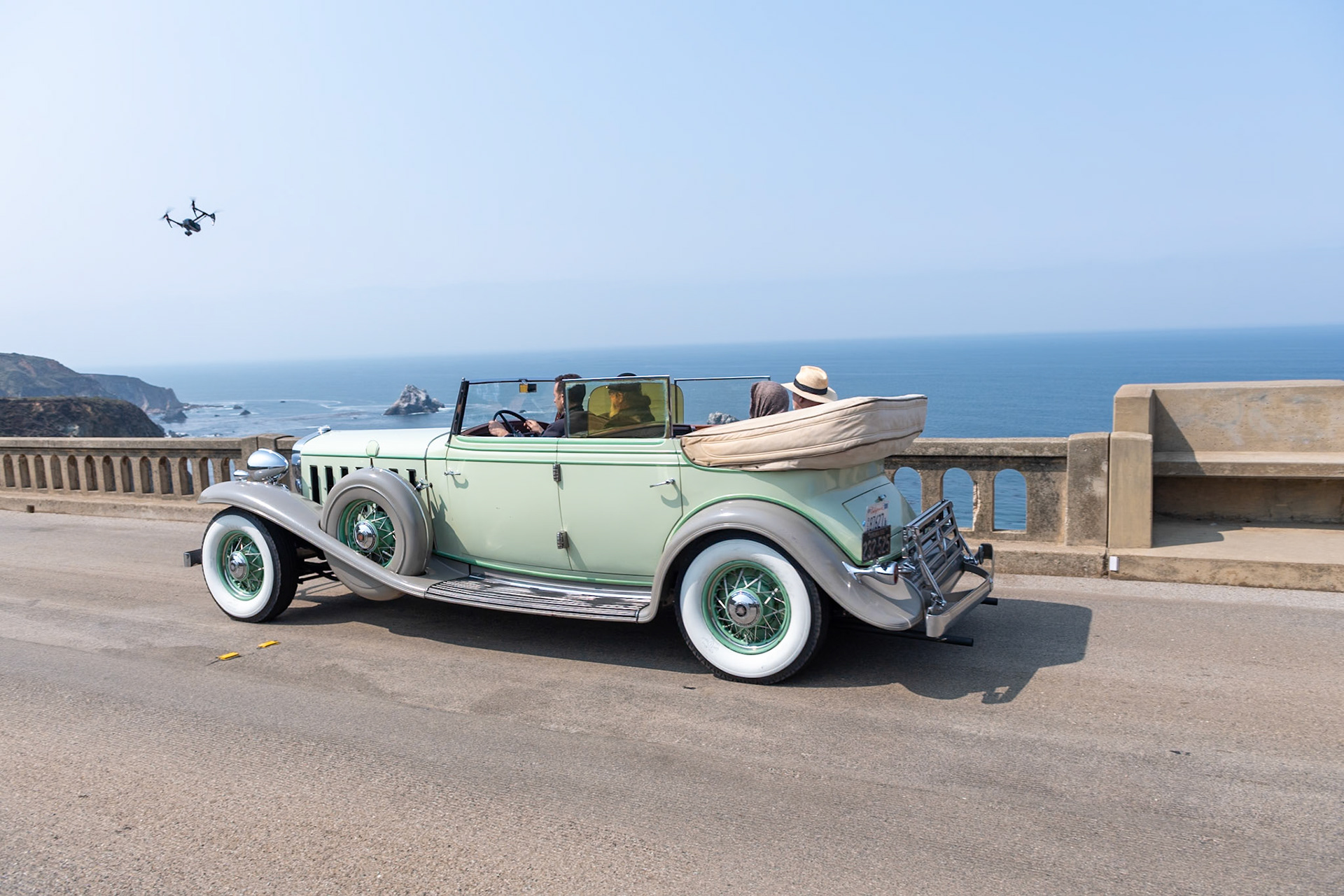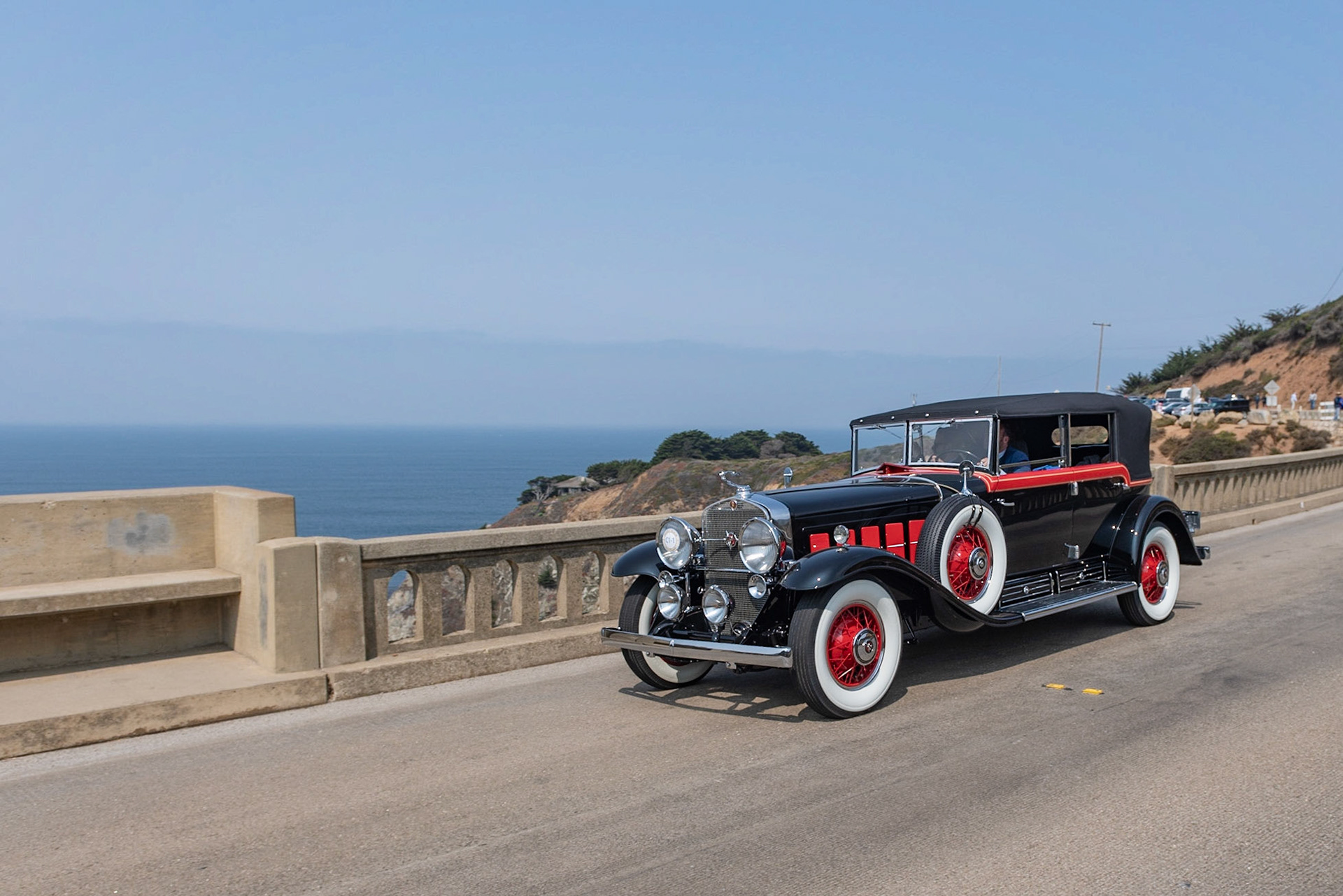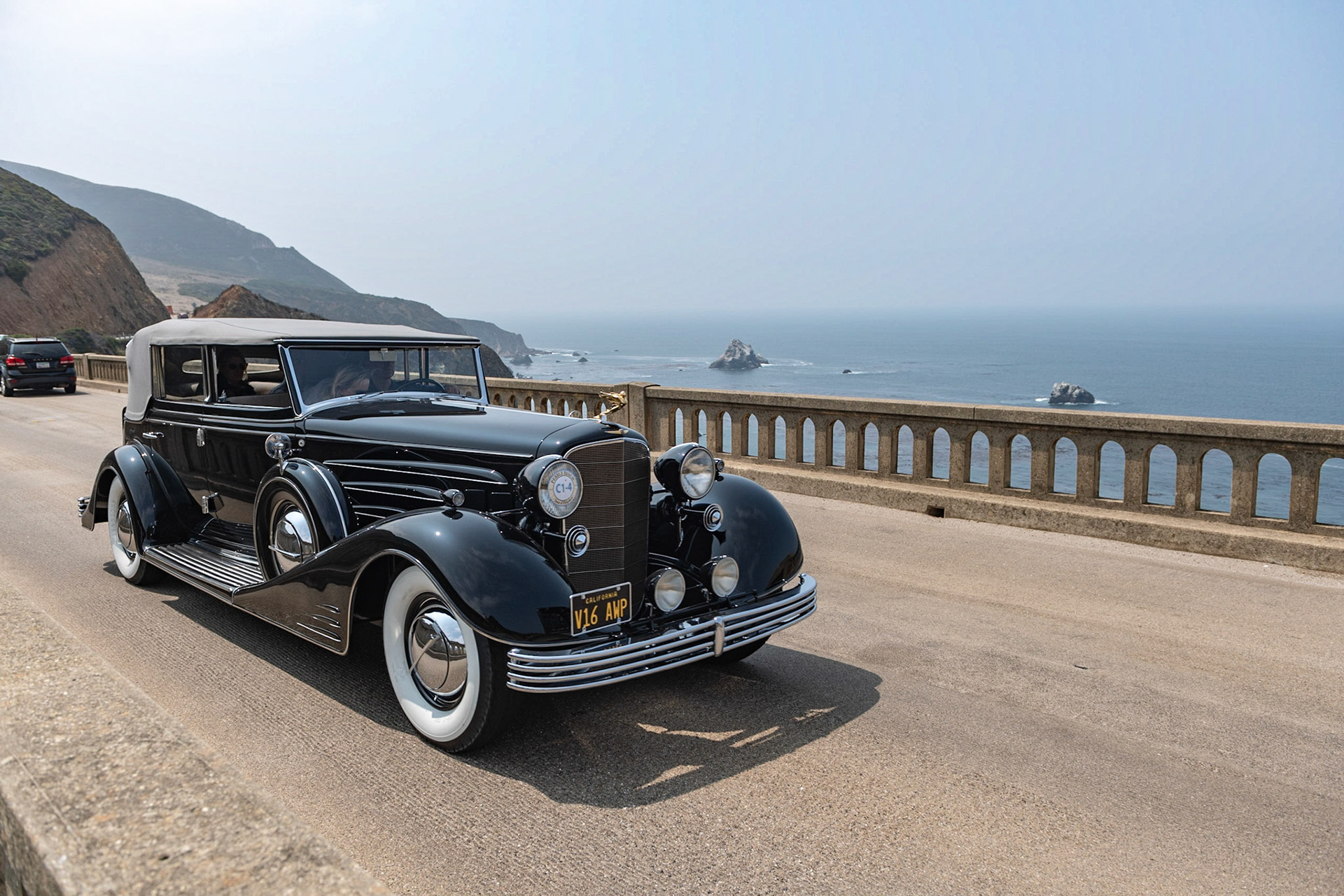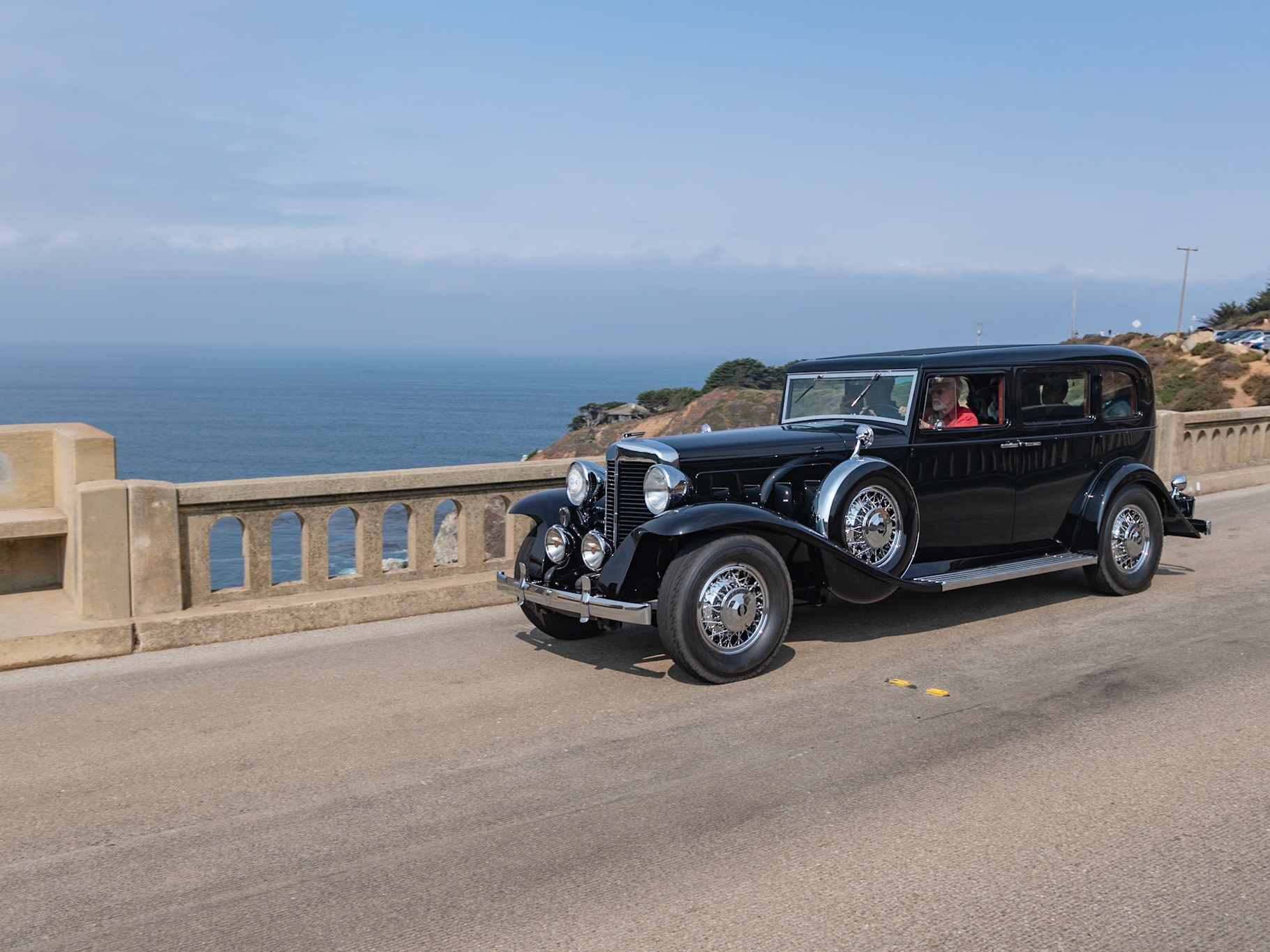
Cadillac introduced its new and luxurious V-16 automobile at the 1930 New York Salon in response to the Duesenberg Model J that had amazed the world when introduced in late 1928. The V-16 had an equally impressive performance, displacing 452 cubic inches and producing 185 bhp. Only 85 Fleetwood sport phaetons were produced on the V-16 chassis and today these cars are extremely rare. This example is fitted with attractive dual cowl coachwork; the cowl for the rear-seat passengers is mounted directly to the rear of the front seat and is raised and lowered by turning a small crank. This gives the car its distinctive low line. The body is sometimes referred to as a four passenger roadster.

Cadillac introduced its new and luxurious V-16 automobile at the 1930 New York Salon in response to the Duesenberg Model J that had amazed the world when introduced in late 1928. The V-16 had an equally impressive performance, displacing 452 cubic inches and producing 185 bhp. Only 85 Fleetwood sport phaetons were produced on the V-16 chassis and today these cars are extremely rare. This example is fitted with attractive dual cowl coachwork; the cowl for the rear-seat passengers is mounted directly to the rear of the front seat and is raised and lowered by turning a small crank. This gives the car its distinctive low line. The body is sometimes referred to as a four passenger roadster.

Cadillac introduced its new and luxurious V-16 automobile at the 1930 New York Salon in response to the Duesenberg Model J that had amazed the world when introduced in late 1928. The V-16 had an equally impressive performance, displacing 452 cubic inches and producing 185 bhp. Only 85 Fleetwood sport phaetons were produced on the V-16 chassis and today these cars are extremely rare. This example is fitted with attractive dual cowl coachwork; the cowl for the rear-seat passengers is mounted directly to the rear of the front seat and is raised and lowered by turning a small crank. This gives the car its distinctive low line. The body is sometimes referred to as a four passenger roadster.

This Cadillac 452A is one of the twenty-one 452 and 452A series chassis built specifically for export in 1931. The V16-engined chassis was ordered by the 32-year-old Maharaja of Orchha through General Motors in Bombay and was one of the first cars to be bodied by Battista Farina at his newly opened Carrozeria Pinin Farina in Turin. The Maharaja was a keen hunter, and the boattail roadster has a raised rumble seat that allows a full 360-degree line of sight for shooting. The car is often described as a tiger hunting car, and it was certainly used for that. In the early 1930s, the car accompanied the Maharaja’s son to England, for his use at college, where it must have caused quite a sensation. The next owner, Indian film director Sheikh Mukhtar, had the car painted pink in the 1960s. The car was exported from India in 1976, and it was acquired by collector Bob Lee in 1988.

This Cadillac 452A is one of the twenty-one 452 and 452A series chassis built specifically for export in 1931. The V16-engined chassis was ordered by the 32-year-old Maharaja of Orchha through General Motors in Bombay and was one of the first cars to be bodied by Battista Farina at his newly opened Carrozeria Pinin Farina in Turin. The Maharaja was a keen hunter, and the boattail roadster has a raised rumble seat that allows a full 360-degree line of sight for shooting. The car is often described as a tiger hunting car, and it was certainly used for that. In the early 1930s, the car accompanied the Maharaja’s son to England, for his use at college, where it must have caused quite a sensation. The next owner, Indian film director Sheikh Mukhtar, had the car painted pink in the 1960s. The car was exported from India in 1976, and it was acquired by collector Bob Lee in 1988.

1941 Cadillac 62Conv. Coupe Denny & Bernadene DochnahlRenton, WA

1941 Cadillac 62Conv. Coupe Denny & Bernadene DochnahlRenton, WA

1941 Cadillac 62Conv. Coupe Denny & Bernadene DochnahlRenton, WA

This Cadillac 452A is one of the twenty-one 452 and 452A series chassis built specifically for export in 1931. The V16-engined chassis was ordered by the 32-year-old Maharaja of Orchha through General Motors in Bombay and was one of the first cars to be bodied by Battista Farina at his newly opened Carrozeria Pinin Farina in Turin. The Maharaja was a keen hunter, and the boattail roadster has a raised rumble seat that allows a full 360-degree line of sight for shooting. The car is often described as a tiger hunting car, and it was certainly used for that. In the early 1930s, the car accompanied the Maharaja’s son to England, for his use at college, where it must have caused quite a sensation. The next owner, Indian film director Sheikh Mukhtar, had the car painted pink in the 1960s. The car was exported from India in 1976, and it was acquired by collector Bob Lee in 1988.

This very special Cadillac 75 convertible was sent by the GM factory to Hess & Eisenhardt, a specialist car conversion company based in Rossmoyne, Ohio, to be completely rebuilt for use by President Eisenhower. Two of these cars were built for the White House motor pool; one was nicknamed “Queen Elizabeth II” and this one was dubbed “Queen Mary II.” Before the war, these Royal “titles” had been conferred on two 1938 Cadillac V16s used by Presidents Roosevelt and Truman. This Cadillac 75 stretched limousine was used in presidential motorcades for Presidents Eisenhower, Kennedy, and Johnson, but when a new Lincoln convertible was acquired for President Kennedy, it was demoted for use as a chase vehicle by the secret service and was, in fact, driving behind JFK on that fateful day in Dallas when he was shot.

After being developed in secret, Cadillac’s V16 engine was proudly launched upon an unsuspecting public at the end of 1929. The only other V16 engine being developed at the time was that of Marmon. This Cadillac 452B All Weather Phaeton is one of only 13 examples designed by Cadillac’s chief stylist, Harley Earl, and bodied by Fisher. This car was first fitted with a Seven Passenger Sedan body, but before it was delivered, the factory received a rush order for a Phaeton, so the car was rebodied and delivered to Wilmer Hall of Virginia. He kept the car until 1976 when it went to Judge North of Maryland. During the 1950s, the car received a partial “refresh” to its body and fittings as well as repairs to the upholstery, but the rest of the car, including the instruments, engine, wheels, and driveline, remains unrestored.

After being developed in secret, Cadillac’s V16 engine was proudly launched upon an unsuspecting public at the end of 1929. The only other V16 engine being developed at the time was that of Marmon. This Cadillac 452B All Weather Phaeton is one of only 13 examples designed by Cadillac’s chief stylist, Harley Earl, and bodied by Fisher. This car was first fitted with a Seven Passenger Sedan body, but before it was delivered, the factory received a rush order for a Phaeton, so the car was rebodied and delivered to Wilmer Hall of Virginia. He kept the car until 1976 when it went to Judge North of Maryland. During the 1950s, the car received a partial “refresh” to its body and fittings as well as repairs to the upholstery, but the rest of the car, including the instruments, engine, wheels, and driveline, remains unrestored.

After being developed in secret, Cadillac’s V16 engine was proudly launched upon an unsuspecting public at the end of 1929. The only other V16 engine being developed at the time was that of Marmon. This Cadillac 452B All Weather Phaeton is one of only 13 examples designed by Cadillac’s chief stylist, Harley Earl, and bodied by Fisher. This car was first fitted with a Seven Passenger Sedan body, but before it was delivered, the factory received a rush order for a Phaeton, so the car was rebodied and delivered to Wilmer Hall of Virginia. He kept the car until 1976 when it went to Judge North of Maryland. During the 1950s, the car received a partial “refresh” to its body and fittings as well as repairs to the upholstery, but the rest of the car, including the instruments, engine, wheels, and driveline, remains unrestored.

1940 Cadillac 75Town Car, Brunn Skip Tetz & Susan Murray-TetzGoshen, NY

1940 Cadillac 75Town Car, Brunn Skip Tetz & Susan Murray-TetzGoshen, NY

1940 Cadillac 75Town Car, Brunn Skip Tetz & Susan Murray-TetzGoshen, NY

In 1930 Cadillac introduced two new engines, a new V-12 and a groundbreaking V-16 engine that immediately placed the company alongside other prestigious manufacturers, including Hispano-Suiza, Lagonda, Rolls-Royce and its chief rival, Packard. Both new engines were designed by Owen Nacker of Marmon fame but they were very expensive. When bodied, a V-16 Imperial Cabriolet started at $6,250 and the top-of-the-line All Weather Phaeton was a headline-grabbing $8,000. This Fleetwood All Weather Phaeton, featuring a special-order division window and an all cloth interior, is one of just seven similar cars built by Cadillac in 1933, and one of only two that have survived.

In 1930 Cadillac introduced two new engines, a new V-12 and a groundbreaking V-16 engine that immediately placed the company alongside other prestigious manufacturers, including Hispano-Suiza, Lagonda, Rolls-Royce and its chief rival, Packard. Both new engines were designed by Owen Nacker of Marmon fame but they were very expensive. When bodied, a V-16 Imperial Cabriolet started at $6,250 and the top-of-the-line All Weather Phaeton was a headline-grabbing $8,000. This Fleetwood All Weather Phaeton, featuring a special-order division window and an all cloth interior, is one of just seven similar cars built by Cadillac in 1933, and one of only two that have survived.

In 1930 Cadillac introduced two new engines, a new V-12 and a groundbreaking V-16 engine that immediately placed the company alongside other prestigious manufacturers, including Hispano-Suiza, Lagonda, Rolls-Royce and its chief rival, Packard. Both new engines were designed by Owen Nacker of Marmon fame but they were very expensive. When bodied, a V-16 Imperial Cabriolet started at $6,250 and the top-of-the-line All Weather Phaeton was a headline-grabbing $8,000. This Fleetwood All Weather Phaeton, featuring a special-order division window and an all cloth interior, is one of just seven similar cars built by Cadillac in 1933, and one of only two that have survived.

Cadillac created the V-16 to exceed the standards of the best automobiles in the world—particularly the Duesenberg Model J in the American market. Cadillac introduced its new ultra-luxurious car with its new 16-cylinder engine at the 1930 New York Auto Salon, where it caused a sensation. They offered a number of Fleetwood bodies on the 1930–31 Series 452A chassis but the most successful was the All Weather Phaeton. The V-16 Phaeton cost more than ten times the price of a contemporary Chevrolet convertible, and few people could afford such luxury due to the shrinking depression-era car market. This particular car was sold new to the jewelers Tiffany in Chicago on March 14, 1930. After several later owners, including well-known V-16 authority Jim Pearson, it was restored to its original factory specification in 1990. It has recently been refreshed by its current owner.

Cadillac created the V-16 to exceed the standards of the best automobiles in the world—particularly the Duesenberg Model J in the American market. Cadillac introduced its new ultra-luxurious car with its new 16-cylinder engine at the 1930 New York Auto Salon, where it caused a sensation. They offered a number of Fleetwood bodies on the 1930–31 Series 452A chassis but the most successful was the All Weather Phaeton. The V-16 Phaeton cost more than ten times the price of a contemporary Chevrolet convertible, and few people could afford such luxury due to the shrinking depression-era car market. This particular car was sold new to the jewelers Tiffany in Chicago on March 14, 1930. After several later owners, including well-known V-16 authority Jim Pearson, it was restored to its original factory specification in 1990. It has recently been refreshed by its current owner.

Cadillac created the V-16 to exceed the standards of the best automobiles in the world—particularly the Duesenberg Model J in the American market. Cadillac introduced its new ultra-luxurious car with its new 16-cylinder engine at the 1930 New York Auto Salon, where it caused a sensation. They offered a number of Fleetwood bodies on the 1930–31 Series 452A chassis but the most successful was the All Weather Phaeton. The V-16 Phaeton cost more than ten times the price of a contemporary Chevrolet convertible, and few people could afford such luxury due to the shrinking depression-era car market. This particular car was sold new to the jewelers Tiffany in Chicago on March 14, 1930. After several later owners, including well-known V-16 authority Jim Pearson, it was restored to its original factory specification in 1990. It has recently been refreshed by its current owner.

In 1937 Cadillac built fifty of their most expensive Series 90 V-16 chassis, and all but two were bodied in-house by Fleetwood. This chassis was delivered to Lausanne, Switzerland, to be bodied by Carrosserie Hartmann per an order by local resident Philippe Barraud, a wealthy playboy of the 1930s. Barraud wanted an outrageous, bespoke automobile to suit his stylish lifestyle. Stretching 22 feet in length, the car was designed in the sweeping cabriolet style of the Delahaye built by Figoni & Falaschi for the 1936 Paris Auto Salon. The car soon suffered several accidents, possibly because its size was unsuitable for small European roads, and it was permanently parked in 1939. Then it was all but abandoned until the summer of 1968 when a second owner acquired it for just $925. Over the following 50 years it changed hands many times and gained several nonoriginal embellishments, but this unique and imposing Cadillac V-16 now has been meticulously restored to its original configuration and its original off-white paintwork with distinctive gray body stripe and fender skirts for its debut at the Pebble Beach Concours d’Elegance.

In 1937 Cadillac built fifty of their most expensive Series 90 V-16 chassis, and all but two were bodied in-house by Fleetwood. This chassis was delivered to Lausanne, Switzerland, to be bodied by Carrosserie Hartmann per an order by local resident Philippe Barraud, a wealthy playboy of the 1930s. Barraud wanted an outrageous, bespoke automobile to suit his stylish lifestyle. Stretching 22 feet in length, the car was designed in the sweeping cabriolet style of the Delahaye built by Figoni & Falaschi for the 1936 Paris Auto Salon. The car soon suffered several accidents, possibly because its size was unsuitable for small European roads, and it was permanently parked in 1939. Then it was all but abandoned until the summer of 1968 when a second owner acquired it for just $925. Over the following 50 years it changed hands many times and gained several nonoriginal embellishments, but this unique and imposing Cadillac V-16 now has been meticulously restored to its original configuration and its original off-white paintwork with distinctive gray body stripe and fender skirts for its debut at the Pebble Beach Concours d’Elegance.

In 1937 Cadillac built fifty of their most expensive Series 90 V-16 chassis, and all but two were bodied in-house by Fleetwood. This chassis was delivered to Lausanne, Switzerland, to be bodied by Carrosserie Hartmann per an order by local resident Philippe Barraud, a wealthy playboy of the 1930s. Barraud wanted an outrageous, bespoke automobile to suit his stylish lifestyle. Stretching 22 feet in length, the car was designed in the sweeping cabriolet style of the Delahaye built by Figoni & Falaschi for the 1936 Paris Auto Salon. The car soon suffered several accidents, possibly because its size was unsuitable for small European roads, and it was permanently parked in 1939. Then it was all but abandoned until the summer of 1968 when a second owner acquired it for just $925. Over the following 50 years it changed hands many times and gained several nonoriginal embellishments, but this unique and imposing Cadillac V-16 now has been meticulously restored to its original configuration and its original off-white paintwork with distinctive gray body stripe and fender skirts for its debut at the Pebble Beach Concours d’Elegance.

1941 Cadillac 62Conv. Coupe Denny & Bernadene DochnahlRenton, WA

In 1930, when the world and US economies were collapsing, Cadillac took the brave step of introducing their new, and expensive, V-16 engine. This 1931 452A V-16 All-Weather Phaeton with coachwork by Fleetwood, Cadillac’s in-house body builder, is finished in the striking color combination of rose red over dark red fenders. The body features several interesting details, such as a vee “Pennsylvania windshield” and a glass division between the driver and the passenger compartments. It is also fitted with dual side mount spares topped with correct Cadillac mirrors, twin Pilot Ray spot lamps, a radiator stone shield, the goddess radiator mascot, and a matching dark-red trunk that has been restored to match the car.


In 1930 Cadillac introduced two new engines, a new V-12 and a groundbreaking V-16 engine that immediately placed the company alongside other prestigious manufacturers, including Hispano-Suiza, Lagonda, Rolls-Royce and its chief rival, Packard. Both new engines were designed by Owen Nacker of Marmon fame but they were very expensive. When bodied, a V-16 Imperial Cabriolet started at $6,250 and the top-of-the-line All Weather Phaeton was a headline-grabbing $8,000. This Fleetwood All Weather Phaeton, featuring a special-order division window and an all cloth interior, is one of just seven similar cars built by Cadillac in 1933, and one of only two that have survived.

Cadillac created the V-16 to exceed the standards of the best automobiles in the world—particularly the Duesenberg Model J in the American market. Cadillac introduced its new ultra-luxurious car with its new 16-cylinder engine at the 1930 New York Auto Salon, where it caused a sensation. They offered a number of Fleetwood bodies on the 1930–31 Series 452A chassis but the most successful was the All Weather Phaeton. The V-16 Phaeton cost more than ten times the price of a contemporary Chevrolet convertible, and few people could afford such luxury due to the shrinking depression-era car market. This particular car was sold new to the jewelers Tiffany in Chicago on March 14, 1930. After several later owners, including well-known V-16 authority Jim Pearson, it was restored to its original factory specification in 1990. It has recently been refreshed by its current owner.

In 1937 Cadillac built fifty of their most expensive Series 90 V-16 chassis, and all but two were bodied in-house by Fleetwood. This chassis was delivered to Lausanne, Switzerland, to be bodied by Carrosserie Hartmann per an order by local resident Philippe Barraud, a wealthy playboy of the 1930s. Barraud wanted an outrageous, bespoke automobile to suit his stylish lifestyle. Stretching 22 feet in length, the car was designed in the sweeping cabriolet style of the Delahaye built by Figoni & Falaschi for the 1936 Paris Auto Salon. The car soon suffered several accidents, possibly because its size was unsuitable for small European roads, and it was permanently parked in 1939. Then it was all but abandoned until the summer of 1968 when a second owner acquired it for just $925. Over the following 50 years it changed hands many times and gained several nonoriginal embellishments, but this unique and imposing Cadillac V-16 now has been meticulously restored to its original configuration and its original off-white paintwork with distinctive gray body stripe and fender skirts for its debut at the Pebble Beach Concours d’Elegance.

After being developed in secret, Cadillac’s V16 engine was proudly launched upon an unsuspecting public at the end of 1929. The only other V16 engine being developed at the time was that of Marmon. This Cadillac 452B All Weather Phaeton is one of only 13 examples designed by Cadillac’s chief stylist, Harley Earl, and bodied by Fisher. This car was first fitted with a Seven Passenger Sedan body, but before it was delivered, the factory received a rush order for a Phaeton, so the car was rebodied and delivered to Wilmer Hall of Virginia. He kept the car until 1976 when it went to Judge North of Maryland. During the 1950s, the car received a partial “refresh” to its body and fittings as well as repairs to the upholstery, but the rest of the car, including the instruments, engine, wheels, and driveline, remains unrestored.

1940 Cadillac 75Town Car, Brunn Skip Tetz & Susan Murray-TetzGoshen, NY















































